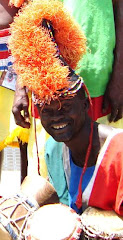The textures and designs are underused in the western world, but in Africa the rich vibrant colours are best used in the exotic clothes which are also embroidered
with wonderful original designs. The country of origin of traditional clothes can be identified by the style and use of material
Melted beeswax is mixed with paraffin and applied to the fabric before being dipped in dye. The beeswax will bind to the fabric and the paraffin wax will allow cracking, which is a characteristic of batik. Several colours are used with a series of dyeing. Thin wax lines can be applied with a canting, a wooden handled tool with a tiny metal cup and spout, out of which the wax can seep.
Other techniques to apply the wax onto the fabric include pouring the liquid wax, painting the wax on with a brush, and applying the hot wax to pre-carved wooden or metal wire block and stamping the fabric. After the final dyeing the fabric is hung up to dry and then dipped in a solvent to dissolve the wax, or simply ironed between paper towels or newspapers to absorb the wax and reveal the deep rich colors and the fine crinkle lines that give batik its character.
Gambian tie dye and batiks are extravagant, rich in different shades of colour and are often seen at tourist markets and are tailored into men’s Kaftans (haftans), women’s yara Wollof, or warambas (grandmubas), skirts, shirts, ladies blouses, as well as bed sheets, curtains and tablecloths.
Mudcloth or bògòlanfini is a traditional Malian fabric dyed with fermented mud, particularly associated with the Bambara. Bògòlanfini is a Bambara word meaning “earthcloth.” To create it, simple cotton cloth is woven, shrunk, and then soaked in a preparation of leaves
from certain trees. An artist then outlines an intricate design, often taking several weeks to cover the entire cloth, with a mud dye.
The areas of yellowish mud are then treated with caustic soda, bleaching them white and creating a stark black and white design. Traditionally, a man will do the weaving while a woman will do the dyeing. In recent years, fashion designers such as Chris Seydou have
employed bògòlanfini in international clothing lines, while Malian painter Ishmael Diabate
has developed it as a fine art form.
Wooden masks, either human, animal or some mythical creature, are one of the most common forms of art in western Africa. In their original context, masks were worn by a chosen or initiated dancer and used for celebrations, initiations, crop harvesting, and war preparation.
During a mask ceremony the dancer goes into deep trance, and while in this state,“communicates” with his ancestors. Masks can be worn in three ways: vertically covering the face: as a helmet, encasing the entire head, and as a crest, resting upon the head, usually covered by material as part of the disguise. African masks often represent a spirit and it is strongly believed that the spirit of the ancestors possesses the wearer
Within the vicinity of most of the major tourist hotels you will find small craft markets called bengdulas made up of a number of stalls offering a selection of items such as tribal masks, wooden carvings, batiks, tie dye fabric prints, beads, gold and silver jewellery and locally made hand woven baskets. There are larger markets at Serrekunda, Bakau and, the most famous of all, Banjul’s Albert Market.
Despite the influence of tourism in creating mass production of such art, there are some really beautiful original good quality handmade items, such as leather hand bags and shoes, hand woven cloths or solid silver jewellery but you will have to search for them. Special
items will be made to order for you in two or three days but they are worth the wait. Watch out for dipped silver bangles! Mostly these can be found being peddled on the beach or by street vendors.
You have to be prepared for the haggle in the markets and also be prepared to do a lot of hard bargaining, the price is always negotiable! So it depend on “your luck” as to the price you pay for any item … Our advice is to start with about 1/3 of the asking price
then, depending on your bargaining skills and your common sense, it is up to you how much you pay!
DON‘T TAKE OFFENCE AT AN EXTORTIONATE PRICE …the starting price is not meant to offend or to “rip you off”!
Bargaining is part of the way of life, and is meant to be part of the fun! It‘s part of the culture and should be treated light-heartedly. In the same vein the Vendor will not really take offence at your low offer even if he/she make out they are, if you cannot agree and you walk away “9 times out of 10” they will call you back …if they are not interested in your offer … then your offer was TOO LOW!
If you can‘t cope with the bargaining most hotels and gift shops will have fixed price
items for sale. You will expect to pay a little more for the convenience but sometimes
you may find a better selection and quality items than the local market.
Contact details and Reservations:
Luigis Complex for the best Gambian self-catering apartments, serviced flats, beachside accommodation, bed and breakfast, restaurant and eco-tourism excursions.
Relax and enjoy your Gambia Holidays with us!
info@luigiscomplex.com
www.luigis.gm/
Tel +220 4460280





































